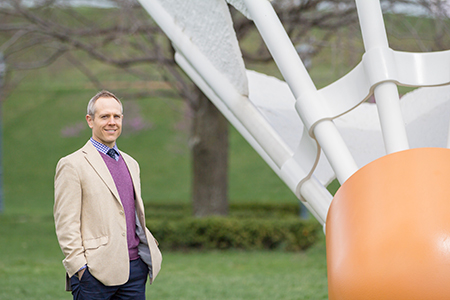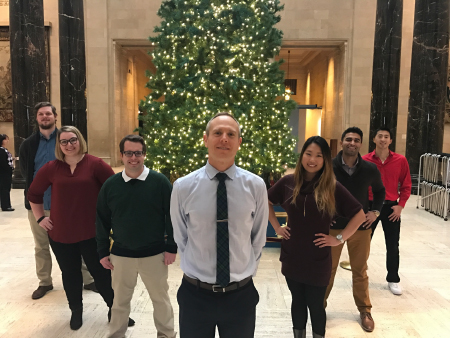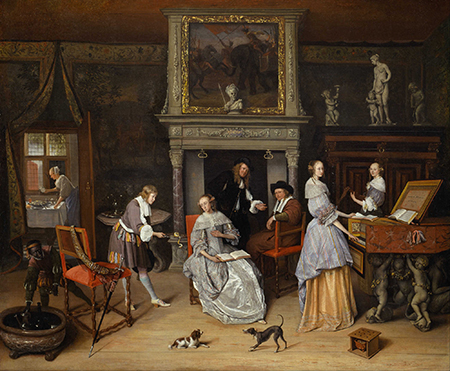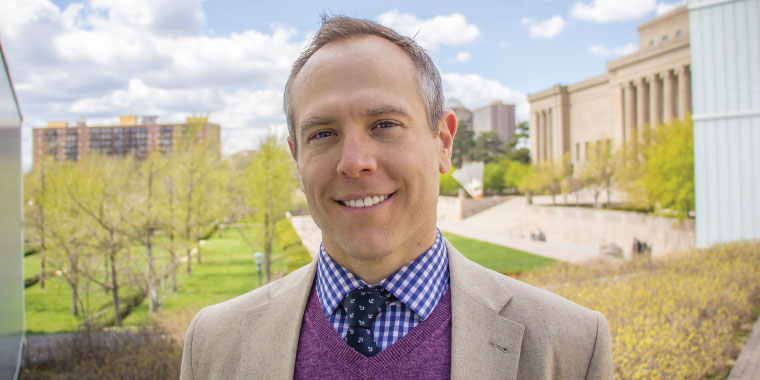Schoen Kruse, PhD, teaches science with little room for subjectivity. As assistant dean for academic affairs and associate professor of pharmacology, one might assume Dr Kruse works more with his left brain, the side more logical and analytical.
KCU anatomy fellows might beg to differ. Dr. Kruse has introduced a session called The Art of Observation in the anatomy fellowship program, that encourages introspection, and yes, some right-brain thinking. This newer element of the fellowship curriculum focuses on aesthetics, feelings and creativity and presents fellows with a learning experience that draws on a more creative and reflective way of thinking.
Dr. Kruse’s class is based on an experience he had while attending Harvard Macy Institute’s Program for Educators in Health Professions. He found himself walking thoughtfully through the Boston Art Museum. As part of the program, carefully crafted exercises in observation, reflection and listening are completed in order to promote discovery from within by tapping into one’s inner self.
 “We were instructed to look deeply at works of art and to reflect on the thoughts and feelings they provoked. It was an exercise that I had never participated in before, and I found it more impactful than I could have anticipated. I quickly determined that there was a real opportunity to implement reflective learning experiences like this at KCU for our students.”
“We were instructed to look deeply at works of art and to reflect on the thoughts and feelings they provoked. It was an exercise that I had never participated in before, and I found it more impactful than I could have anticipated. I quickly determined that there was a real opportunity to implement reflective learning experiences like this at KCU for our students.”
Based on his experience at the Harvard Macy Institute, Dr. Kruse adapted The Art of Observation and incorporated it as an element in a semester-long required course for anatomy fellows - Foundations in Teaching and Learning I: Theory and Practice.
Nationally published research shows that many practicing physicians and physicians in training struggle with anxiety, burnout, and even depression.
“The volume of information in medical education is daunting and can be overwhelming. Learning to become a physician is stressful," Dr. Kruse said. “So, hitting pause every once in a while and engaging in reflective practice is a great opportunity to take a break from the daily grind of medical school and clinical practice. Overall, I don’t believe that we, as professionals, spend enough time reflecting and/or teaching our learners to reflect. When we are able to tap into our inner selves, we’re better equipped to succeed in our lives, relationships, and careers and to consider the needs of our patients.”
The Art of Observation encourages individual reflection in a setting that lends itself to increased opportunities for sharing thoughts though open discussions. The museum itself serves as an immersive environment in which students are led through an exercise that takes a three-tier approach. Fierst, group analysis of classic portraiture and life scenes; next, students' studying and presenting on works of modern art; and, finally, students individually identifying, reflecting and presenting on pieces of their own choosing. This model inspires a new approach to introspective learning for medical students.
 L-R:Anatomy Fellows Clark Stephenson, Amy Whitaker and Clayton Oakley; Dr. Schoen Kruse; Anatomy Fellows Dami Lee, Viren Rana and Joe Pankratz
L-R:Anatomy Fellows Clark Stephenson, Amy Whitaker and Clayton Oakley; Dr. Schoen Kruse; Anatomy Fellows Dami Lee, Viren Rana and Joe Pankratz
Dr. Kruse begins the session at the Nelson-Atkins Museum of Art in Kansas City, Mo., where he meets with six students and introduces two pieces of art. He asks each student to study the paintings and reflect upon their observations.
“The pieces might be portraits of individuals or a group setting. I ask each student to individually think about what’s happening in the painting. All topics are on the table, from wealth and social class to the health of the those depicted in the paintings. We take time to discuss what each student observes and, most importantly, take time to listen and reflect on what each student has to say. There are no right or wrong answers in this exercise.”
The second element of the class presents works of modern art. Students work in pairs to study the artwork and reflect on how the artwork relates to health care. Each team then teaches the group about the piece of art and presents what they see as it relates to health care. More time is given for listening and reflection.
The third and final activity sets each student off on a quest alone, seeking out a piece of art that triggers a response to a set of questions posed by Dr. Kruse. They locate artwork that might speak to a joy experienced during training, or a struggle they’ve had, or something that evokes a feeling from the past. After each student locates the artwork that answers their question, the group visits each piece while the student explains why they chose the particular work.
The Art of Observation session is scheduled near the end of the foundations course in order to take full advantage of the bond of trust and respect students develop over the semester. Dr. Kruse says this makes it more comfortable for them to dive deeper into the subject matter and practice reflective learning.
 |
You don't have to be a history buff to benefit from The Art of Observation. Take a look at the piece, "Fantasy Interior with Jan Steen adn the Fmaily of Gerrit Schouten," circa 1660 by Jan Steen. Dr. Kruse's program viewed it during a recent visit to the Nelson Atkins Museum of Art. Hone your skills by asking yourself questions such as: How does this piece make me feel? What is happening in this piece? What does it tell us about society? What does it tell me about the individual people portrayed? Their wealth? Their health? |
“This is a difficult exercise,” Dr. Kruse said. “Most times when we visit a museum, we look at art and perhaps read the typed card that identifies the artist with a little biographical information and move on to the next piece. The Art of Observation asks students to look deeply, reflect, share and listen to the feelings of others without judgment. For many, this is not an easy thing to do, but is beneficial for our students’ state of mind and in preparation for their move into practicing medicine.The course can help students to reflect on the needs of patients and families, looking beyond the surface to really listen and learn.”
Medical students have embraced this new aspect of their curriculum. In an atmosphere that is typically charged with tension, stress and the drive to succeed, students have benefited from the Art of Observation. Nicolina Smith (COM ’18) said it was both enlightening and insightful.
“It was interesting to observe the comfort level of my classmates when we were asked to reflect on our feelings,” Smith said. “You would think that as future physicians we're in touch with our emotions and feelings, but we’re often not. During medical school we’re in such a constant state of high stress we tend to push our humanity aside and forget how to have feelings other than stress and anxiety. The Art of Observation forced me to exit my comfort zone and reflect on my feelings and those of my patient.”
Viren Rana (COM ’19) said the experience helped him to be more introspective, which is something he doesn’t take much time to do with the rigors of medical school.
“As medical students, we are always memorizing concrete facts, analyzing data, looking at research to back up everything we think, and seeing what is wrong with everyone,” Rana said. "Never do we try to think about our own mental health, our own journey, all that we have accomplished or want to accomplish. I learned that we can discover so much about ourselves and others through art.”




(0) Comments